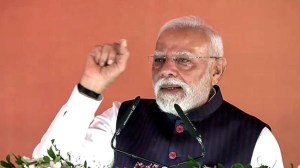Out of the box, into the stadium
You'd think that Indian sport, starved as it is of good news, would embrace this development with both arms. Yet the fact that this is one o...

You’d think that Indian sport, starved as it is of good news, would embrace this development with both arms. Yet the fact that this is one of the more exciting seasons in Ranji Trophy cricket appears to have sunk without trace. The good news is in abundance. Some of the state associations are making a conscious effort to improve their lot by bringing in sponsors, preparing sporting pitches, even hiring fitness trainers. The BCCI has, finally, woken up and hiked the money available to domestic players. And the players have responded, with several stellar performances already in the three rounds of matches this season.
There is, though, much left to be done. Indeed, the Board has done the easy bit first; releasing money from its coffers requires only minor mental adjustment, even for a notoriously parsimonious organisation. The biggest challenge lies in changing its own attitude towards domestic cricket: that is a self-propelled assembly line to produce cricketers who will emerge anyway, however good or bad for the system. Because it’s only when the Ranji Trophy, and other domestic tournaments, rise in the Board’s priorities that they will matter to the public. And, without the people, the tournaments are dead in the water.
For instance, is there any reason why the Ranji Trophy lacks a sponsor? If the BCCI has perfected one trick, it’s the art of finding sponsors for its tournaments. Every home international series, even a triangular involving Kenya, has a sponsor; the premier domestic tournament doesn’t. It’s not just about the money; a good sponsor, an MNC, say, will professionalise the system, insist that its profile be raised, ensure good television coverage, pressurise the stars on its roster to make appearances. That in itself could have a domino effect.
To begin with, this could bring in the crowds, which are currently very conspicuous by their absence. It seems, at times, that those who govern the game spend their time setting up barriers to prevent the public from watching Ranji cricket. The fiasco at Delhi’s Roshanara Club, where bonafide members of the press and the public were barred from watching a Ranji match (even the thought of its boggles the imagination), is matched for ludicruousness only by the sheer indifference with which those in charge — whether at the DDCA or the BCCI — responded.
Writing in this paper recently, the eminent cricket journalist Peter Roebuck observed that the BCCI is guilty of treating spectators with utter contempt, given the condition of our stadiums and the manner in which we have to watch a match sitting there. His outrage, though valid, underlines his ignorance of the basic fact that sport in India exists not for sportsmen or spectators but administrators.
Roebuck’s other point is debatable; that without spectators the game will become bankrupt. That is the problem with Indian cricket: it is not a game based, or dependent, on the support of the man in the stands. The Board’s coffers will not be affected in the least if every domestic match is played in front of empty stands for the next five years because, thanks to TV rights, it has already earned its income for that period.
If the BCCI wanted, it could step in and stop the rot. It could ensure that selectors watch key matches — they are paid to do so; it could, with just a bit of planning, prepare a domestic schedule that is not forced to compete with international matches. That itself could ensure that the top cricketers play domestic cricket; not always a given, for even when the Mumbai Test against Australia left cricketers with days to spare, and a slew of Ranji dates cropped up obligingly, most of our stars chose to look the other way. Few took up the opportunity to play themselves into form.
This is just about poor old Ranji, fighting to escape from a life in the shadows. If the Board really wants to improve cricket long-term, there are many other tournaments that need the same amount of care and attention. Cricket, like any other sport, is not the latest Korean electronic gadget which you plug in and forget about for the next 10 years. Competing as it is with public attention spans, it requires constant creative thinking, frequent tinkering, booster shots.
Cricket boards the world over are trying new schemes to bring back the crowds. Jagmohan Dalmiya told this paper that Twenty20 is not for India. Fine, but what is? Even the ossified Indian Hockey Federation is rising from its slumber and setting up a domestic league aimed at pulling in the crowds, not merely TV revenue. That, if nothing else, should spur the BCCI into action.





- 01
- 02
- 03
- 04
- 05


























